For a long time, the transmission and drive webpage on the kartbuilding.net website has been lying idle, and unfinished. This article covers one of the unfinished articles, “One single gear, using a centrifugal clutch, and chain drive.”.
About Centrifugal Clutches
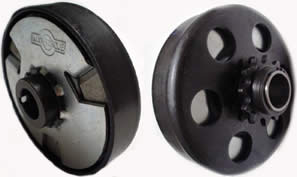 The Centrifugal clutch is one of the most popular and simple methods of transmitting power from the engine to the rear wheels in a go-kart/go-cart. This type of clutch is fully automatic, and works depending on the speed (revs) of the engine. If the engine is turning over very slowly, then the centrifugal clutch is disengaged, and the kart comes to a stop. If the engine speeds up (increase Revs Per Minute rpm) then the automatic clutch will engage, and the kart will move forward.
The Centrifugal clutch is one of the most popular and simple methods of transmitting power from the engine to the rear wheels in a go-kart/go-cart. This type of clutch is fully automatic, and works depending on the speed (revs) of the engine. If the engine is turning over very slowly, then the centrifugal clutch is disengaged, and the kart comes to a stop. If the engine speeds up (increase Revs Per Minute rpm) then the automatic clutch will engage, and the kart will move forward.
There are two parts/components to every Centrifugal Clutch:
- Bell Housing & Sprocket
This bell housing, with its small sprocket connected to the rear axle via a drive chain, spins freely on the engine‘s output shaft, and as a result will need some grease and oil to keep it in good running order. With the engine turned off, the kart can be pushed forward, driving the chain, and spinning the bell housing freely. - Center Shaft with Weighted Friction Shoes
This Center Shaft/Unit is directly attached to the engine‘s output shaft. It is attached to the output shaft via a “keyway” and “grub screw” as will be discussed in the Fitting section in this article. Once the engine speeds up, this Center Shaft will expand and grip the bell housing, and in turn drive the chain.
These types of clutches can get very technical, in terms of power and speed ratings. There are numerous types of clutches available, with various “inner bore diameters”, “horsepower ratings”, “RPM engage\disengagement ratings”, “sprocket & chain sizes”. It is advisable to find out the essential information for your engine, if you are going to buy one of these centrifugal clutches. The small sprocket which comes attached to the “Bell Housing” needs to match the pitch and width of your large rear sprocket on the rear axle of the go-kart.
Buying/Sourcing a Centrifugal Clutch for a Go-Kart/Cart
The best places to get/buy these types of clutches are: your local karting arena, ebay, www.northerntool.com, www.cometkartsales.com. Don’t go and buy the first Centrifugal clutch you see. Shop around for a cheap quote. Also – try and get a typical and well known clutch (especially of you are buying a brand new one), as the “friction shoes” tend to wear quite quickly depending on your gear ratio. Comet type centrifugal clutches are the most well known brand.
Fitting a Centrifugal Clutch for a Go-Kart
Once you have obtained a suitable Centrifugal clutch, and depending on whether it has the correct “inner bore diameter”, fitting will be relatively straight forward. As mentioned earlier, there are 2 pieces/components to the Centrifugal Clutch: the Bell Housing, and the Center Shaft.
The bell housing goes onto the engine shaft first, with its concave bell housing facing outwards. This bell housing spins freely on the engine’s shaft, so make sure to put some grease between the inner bore diameter of the housing and the outer diameter of the engine shaft. Push the bell housing in on the engine shaft as far as possible (until it hits the flange on the engine).

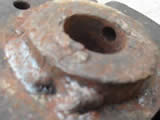
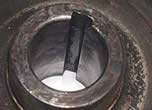 The Center Shaft with its Friction shoes is placed onto the engine next. There should be a “keyway” cut into the inner diameter of the clutch shaft which should align with a keyway in the engine’s shaft. This keyway makes sure that the “Center Shaft” will rotate with the engine. To stop the “Center Shaft” from slipping out off the engine shaft, there is a hole to allow a “grubscrew”. A grubscrew is where a threaded small bolt will screw through the Center shaft and tighten in on the engine shaft. You may or may not receive the rectangular metal “key” with the centrifugal clutch or not. I suggest you visit a lawnmower repair shop or a hardware store to obtain a suitable “key”. Below is a photo of the Centrifugal clutch transmission complete. A plastic chain guard can also be seen. If your engine does not have a keyway, and perhaps has another PTO (power take off) Shaft Type(s) as can be seen here, then you may have to resort to welding the “Center Shaft” to the engine’s output shaft. This should only be done as a last resort.
The Center Shaft with its Friction shoes is placed onto the engine next. There should be a “keyway” cut into the inner diameter of the clutch shaft which should align with a keyway in the engine’s shaft. This keyway makes sure that the “Center Shaft” will rotate with the engine. To stop the “Center Shaft” from slipping out off the engine shaft, there is a hole to allow a “grubscrew”. A grubscrew is where a threaded small bolt will screw through the Center shaft and tighten in on the engine shaft. You may or may not receive the rectangular metal “key” with the centrifugal clutch or not. I suggest you visit a lawnmower repair shop or a hardware store to obtain a suitable “key”. Below is a photo of the Centrifugal clutch transmission complete. A plastic chain guard can also be seen. If your engine does not have a keyway, and perhaps has another PTO (power take off) Shaft Type(s) as can be seen here, then you may have to resort to welding the “Center Shaft” to the engine’s output shaft. This should only be done as a last resort.

Typical Gear Ratio and Chain Drive Setup
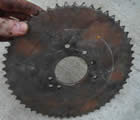 On Centrifugal Clutches, the small sprocket attached to the “Bell Housing” has typically 10 teeth (although this can vary). As a rough estimate, a gear ratio of 5:1 is needed for a standard/typical go-kart/cart, with a 5hp engine running at 3500 rpm, and with rear wheels of diameter 300mm or 12inches. The speed of the go-kart can be calculated based on this “gear ratio” combined with rpm of the engine and diameter of the rear wheels (Calculate speed of go-kart). A large sprocket with 50 teeth for the rear axle can be difficult to obtain. Ask for this large sprocket at the time you are buying the centrifugal clutch and it will save a lot of looking.
On Centrifugal Clutches, the small sprocket attached to the “Bell Housing” has typically 10 teeth (although this can vary). As a rough estimate, a gear ratio of 5:1 is needed for a standard/typical go-kart/cart, with a 5hp engine running at 3500 rpm, and with rear wheels of diameter 300mm or 12inches. The speed of the go-kart can be calculated based on this “gear ratio” combined with rpm of the engine and diameter of the rear wheels (Calculate speed of go-kart). A large sprocket with 50 teeth for the rear axle can be difficult to obtain. Ask for this large sprocket at the time you are buying the centrifugal clutch and it will save a lot of looking.
Centrifugal Clutch from a Chainsaw
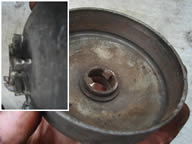 Instead of buying a purpose go-kart centrifugal clutch, it is also possible to get similar centrifugal clutches in “chainsaw engines” and “mopeds/scooters”. Although these types of clutches were not designed specifically for a go-kart it is possible to adapt these to suit a different engine. As can be seen in the photo on the left, a smaller “inner bore diameter” will be found in clutches from chainsaw engines. Also, instead of a small drive sprocket attached, there will be a special star shaped sprocket, which typically drives a cutting chain. A small drive sprocket will instead have to be welded to the “Bell Housing”.
Instead of buying a purpose go-kart centrifugal clutch, it is also possible to get similar centrifugal clutches in “chainsaw engines” and “mopeds/scooters”. Although these types of clutches were not designed specifically for a go-kart it is possible to adapt these to suit a different engine. As can be seen in the photo on the left, a smaller “inner bore diameter” will be found in clutches from chainsaw engines. Also, instead of a small drive sprocket attached, there will be a special star shaped sprocket, which typically drives a cutting chain. A small drive sprocket will instead have to be welded to the “Bell Housing”.
Centrifugal Clutch from a Moped/Scooter
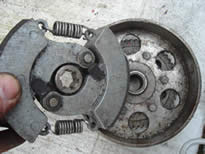 Inside mopeds/scooters there are also centrifugal clutches, however these are slightly different in the fact that they are “wet clutches”, where the “Bell Housing” and “Weighted Center Shaft” run in an oil bath! It might seem impossible at first that a clutch can run in oil, however the oil keeps the clutch cool and free from maintenance. Again similar to the chainsaw type centrifugal clutch, there will have to be adaptations done, as there will be a “Splined” inner bore which will need to be drilled out to suit the engine’s output shaft.
Inside mopeds/scooters there are also centrifugal clutches, however these are slightly different in the fact that they are “wet clutches”, where the “Bell Housing” and “Weighted Center Shaft” run in an oil bath! It might seem impossible at first that a clutch can run in oil, however the oil keeps the clutch cool and free from maintenance. Again similar to the chainsaw type centrifugal clutch, there will have to be adaptations done, as there will be a “Splined” inner bore which will need to be drilled out to suit the engine’s output shaft.
In some mopeds/scooters there are 2 centrifugal clutches each which engages at different rpm of the engine. Therefore when the scooter is going slow and the engine is slow, the first centrifugal clutch engages. This provides a high gear ratio giving extra torque at low speeds. When the moped is moving at an average speed, and the engine turns faster, the second centrifugal clutch with a lower gear ratio kicks in and changes the gear ratio. This setup is very complicated involving a ratchet type free wheel system and is not feasible for use on a kart. It is possible to adapt and use one of these clutches however on a kart.
Conclusion to Centrifugal Clutches, Chain Drive and a Single Gear Transmission for a Go-kart
Having a clutch in a kart allows for great freedom, where the engine can be started and the kart can remain stationary. It also allows the driver to stop the kart without having to turn off the engine. Depending on the weight of the kart, the speed and power of the engine, a centrifugal clutch may not be ideal, but it will work. It is the most effective and simple Single Gear Transmission for a Go-kart. It is referred to as a “Single Gear Transmission” because there is only 1 speed and 1 gear ratio that the kart can go at. As a result of there been only 1 gear ratio, there has to be a hard line drawn between fast take off speed and high end speed.
If you have any comments or queries on this article, feel free to contact the author at: kartbuilding [at] gmail.com
how would you fit a moped clutch on the engine bore once you have drilled it out? should it be welded or some kind of screw inserted?
Hi Will,
First, I’m not sure if moped clutches are meant to be run in a oil bath (considered wet clutches). I tried this once, and I had to keep applying oil to the clutch, as it smoked and burnt out quick.
Anyways, regarding your question:
If there is a keyway/groove in the engine shaft, then you could file/cut a matching groove in the moped clutch. See Step 1 on the top left of the following image: http://kartbuilding.net/Lawnmower_Powered_Wooden_Go-Kart_Plans/JPG-Plans-Metric/Drawing-14_Rear-Axle-Assembly-3.jpg
(this shows where you can drill a 5mm hole into the moped clutch, and using a file square it out. Therefore it will be able to accept a square key (piece of 5mm plate steel cut to size).
If there is no keyway on the engine shaft, it would be quickest to weld the clutch to the engine’s output shaft. It worked perfect for me, however I did have to grind off the weld with an angle grinder to take the clutch off.
Best of luck with it.
-steve
ive recently purchased a used go cart ( manko product). and ive installed a new centrifugul clutch.. am now aware that it needs lubrication … is there a photo I can go to to show where to apply the oil.. do I need to remove clutch to do so ??? Thanks for any help you can give.
MM
Hi Mark,
Yes indeed. You need to lubricate the bushing on the Bell Housing part of the Clutch. This part needs to spin freely on the output shaft of the engine. I would apply some grease and oil. I would recommend applying oil and grease (require a removal) every few days.
I tried searching for a Manual/Document but couldn’t get one easily. There is some information on the following YouTube Videos:
http://www.youtube.com/watch?v=3-SAGjUidZs
http://www.youtube.com/watch?v=2CfunfQyFes
Best of luck
will this cluch work on a go kart and not take off
Hi Anthony,
Yes. This clutch will allow the engine to start and run a low revs. Then when you increase the speed of the engine, the kart will take off.
This clutch also lets you stop a go kart, and leave the engine running.
hey, i just recently bought a go cart and a mini bike on craigslist for $50. the only problem is that the engines need alot of work(new ones). But they came with the clutches but dont know if they are still good…How can i tell?
Hi Hunter,
Unfortunately, apart from a visual inspection, its difficult to see how good the clutches are. You will only be able to tell once the drive is setup and under a load.
Visually, you can tell a good bit from looking at the clutch. You should be able to see the thickness of the clutch pads/shoes and see if there is much wear left.
Anyways, you seem to have gotten a bargin on craigslist. I must check it out too and see if there are any parts or bits and pieces I need.
I’d be careful in tossing them engines just yet. I’ve resurrected many an old engine with a good breakdown and assembly. It will all be part of the fun.
Best of luck,
-steve
I have a cart wagon with 10 inch wheels, 2 ft by 4 ft by 12 inch. Want to haul wood with the wagon that weighs approx 100 lbs. I tried a 3.5 centrifical clutch on a 5 horsepower, rear mounted engine with a 3.5 pulley on a drive rear axle. When I started it, it did not move and the clutch smoked and turned bright blue. I would like to know what size gears to use and how to set it up, using a chain drive or what would work best. Thanks for the information.
Hi Marshall,
You would need at least a ratio of 5:1 between the engine and the rear axle.
This means, you need a pulley/sprocket 5 times bigger than the engine, on the rear axle.
If you can’t get a large enough sproket on the rear axle (around 8 inches), you will have to setup a “jackshaft”. See: http://kartbuilding.net/gallery/v/OtherPeoplesKarts/OscarForand/P1010103.JPG.html
The chain drive works best. Also, you can get different types of centrifugal clutches with ones that will not slip as much. However from the sounds of it, you need to fix the ratio between the pulleys/sprockets on the engine and the rear axle.
Best of luck with it.
Hey man,
I was wondering when you say you need at least a 5:1 ratio do you mean it wouldn’t be good to go with a lets say 3:1 or like a 7:1? Thanks.
@Brandan: Yes. 5:1 is a good average gearing ratio which I have found myself. Note: It does depend on the size of your rear wheels and RPM of your engine.
If you went with 3:1, you’d burn your clutch out. If you went with 7:1 you’d go too slow. You will know when you drive the kart if the gear ratio is correct.
The engine on my 25 yr old quad died. It’s a 25 yr old Polaris 2-WD, had a 230cc 2 stroke. It also has a snowmobile style centrifical clutch system. I was thinking of installing a 6.5 hp store motor in it,but now that has a 3/4″ straight shaft. The drive clutch from the quad has a tapered shaft. Could I use one of those go cart sprocket clutches on this rig? What would I use for a driven sprocket? Don’t need high speed. 30mph is plenty. Thanks.
@Frank: Yes – a go-kart centrifugal clutch as on this page is exactly what you need for the 3/4″ straight shaft.
This clutch comes with a standard size sprocket which you should be able to use. See: http://kartbuilding.net/gallery/v/Kart_Clearance_and_Memories/DSC01031.JPG.html
You should be able to weld a different sprocket if need be to the go-kart centrifugal clutch. I done some modifications to a go-kart clutch. See: http://kartbuilding.net/gallery/v/Kart_Clearance_and_Memories/?g2_page=11
You might want to explore options of making a sleeve to mount the drive clutch from the quad (tapered) onto the 3/4″ straight shaft of the 6.5hp motor.
Best of luck with it.
That might be the best idea. Since the 2 stroke is shot, I could probably cut off the end of the shaft,and have it machined out to 3/4″ ID to fit over the straight shaft. Not sure about the difference in the rpms( idle – full throttle)between the motors,and whether it might affect the engagment of the drive clutch, but it might be worth a shot.
Thanks Steve!
Oh, yeah. 2 Stroke engines generally run at higher RPM. Still, it would be worth trying. Not sure if it would be easier to machine a sleeve to fit the clutch onto the 3/4″ shaft. Typically the drive shaft of an engine would be heat treated and may not be the easiest to machine. I’d just try and machine a mild-steel sleeve for it.
Do you know where I can geta Clutch witha 1 inch bore and 12 tooth gear for a 53chain size. Long story putting a Briggs 9hp on a hammerhead got kart
I have a go kart but has bad low end power. I have a 14 top sprocket and a 38 rear sprocket if I lower the rear sprocket to a 34 tooth will that help go through sand
@bobby: For better torque and power (for going through sand etc.), you need to increase the number of teeth on the rear sprocket. This will increase the drive ratio between the engine and the rear axle and give more power.
I’m rebuilding a manco critter go kart I got from a junk yard. It doesn’t have a live axle. I put a 5hp Briggs&Stratton engine on it with a 13 tooth max torque centrifugal clutch 35 chain. I have the old axle sprocket off it that has 60 teeth and I also bought a 72 teeth sprocket. With the 72 it goes really fast on flat smooth surface and the tire will spin out a bit when taking off. I live on a farm with lots of pasture and it doesn’t do well at climbing hills. I tried putting the 60 tooth on and it still does good but the wheel doesn’t spin out and it can’t really get over a tiny bump. What do I need to do to get it geared right so we can climb the hills of our pasture and also keep a good bit of the speed.
@Nate B: With 13 teeth on the clutch, and 72 teeth on the rear axle, the gear ratio is 5.5:1 The size of your rear wheels also makes a difference. If you have large rear wheels, this counteracts the large rear sprocket.
You want as big a gear ratio as possible. Its not realistic however to go with too large of a rear sprocket. You’d need a setup similar to: http://kartbuilding.net/proper_gearing_down_of_a_kart_using_tranny_axle.jpg
That or, a torque converter.
I have a Honda Gx 340
10.7 Hp @ 3600rpm
19.5 Torqe @ 2500rpm
I Have a 60 tooth sprocket on the Axle #40 chain im using now
The tires are Carlisle Turf Saver II Tires 20 x 8.00-8
1 inch shaft I had made to accomidate a 1 inch burro clutch
Cart is KINDA HEAVY
Uses: Trailing,Mudding,Towing a little trailer, going up hills.
Top speed: I dont care as long as it can do the things listed above a higher top speed over 25 MPH would just be a plus.
What gear ratio do I need?
What Centrifugal clutch should I buy?
What amount of teeth should I have on the clutch for the existing sprocket?
I already bought a clutch from northern tool the cart wouldnt move it tried to go and then it started smoking and tried rooling but i had to push it to get it to srtrt. Then it locked up and now when i start it the wheels move instantly
i have a kart with a 300 cc olimpic snowmobile engine could i put a centrifucal on it
or torque converter
@Eric: With a 300cc engine, it might be better to use a torque converter. With a high-power engine, a torque converter will make better utilisation of the engines power, compared to a centrifugal clutch.
@Mike: What diameter are the “Carlisle Turf Saver II Tires 20 x 8.00-8”? Are they 20 inch diameter? By the sounds of it, you’d need nearly a gear ratio of 6 or 8:1. You said you have 60th on the rear sprocket on the axle. How many teeth are on the clutch?
You might have to setup a tranny axle setup. See: http://kartbuilding.net/proper_gearing_down_of_a_kart_using_tranny_axle.jpg
With a bit of work and force, you should be able to free out the centrifugal clutch. Get some WD40 or similar, spray the clutch, take it off the engine shaft and take apart the clutch to get it working again. You can see some photos of a similar clutch at: http://kartbuilding.net/gallery/v/Kart_Clearance_and_Memories/DSC01103.JPG.html
Best of luck with it.
-steve
I recently purchased a new engine from Harbor Freight for my mini bike. The engine shaft diameter is 5/8 inch. I have a clutch with a 5/8 inch bore that appears too small for the engine shaft. Is this common? How can I remedy?
@Hal, I’ve seen centrifugal clutches to have a tight fit. You may have to get a vernier calipers and actually measure the shaft and the clutch bore. I’ve also seen some engine shafts where the end of the shaft is mushroomed a little. So while the main shaft is OK, the end is a little bigger. In this case you could maybe try taking off this burr and see. Again actually measuring the shaft and bore with a calipers would be a good idea. Make sure the engine shaft is cool (otherwise if it was hot, it would be expanded slightly). Also, is there rust or debris on the engine output shaft? You could start the engine, and using some “sandpaper” or wire wool, hold it against (very carefully) the spinning output shaft. This will clean the shaft and may give you the 1000″ inch you need to get the clutch on.
The engine shaft and the clutch are both new – neither has been run or used. I initially attempted to use my press to install the clutch, but excessive pressure built quickly so I stopped and removed the clutch with the press. I actually tried a second new clutch with the same results. The specs on the engine indicate 5/8 inch and also say 16mm. Just wondered if anyone has possibly experienced tolerance issues with the inexpensive Predator engines from Harbor Freight that are made in China. I did mike the shaft and bore there appears to be about 0.004″ difference between the 2. I thnk that’s too tight, so I’m thinking I need to buy a B&S motor. Thoughts?
@Hal, That’s a pity. With both new clutch and engine, you’d think it’d all work nicely! And you tried a second clutch and it was no good either! It doesn’t sound like there is a quick fix. I’d say the difference is the conversion between millimeters and inches. I don’t know. I take it you wouldn’t know anyone with a lathe who could machine out the clutch? I don’t know if heating the clutch center would help either. It sounds like it could be too tight a fit.
I’m not sure how much the clutch would cost. I’d nearly call around some suppliers, and see if you could get a different clutch to suit the engine shaft. I myself don’t have any experience with Predator engines from Harbor Freight.
I’ll keep playing a little longer before I throw in the towel. I had thought about trying to machine a couple thousandths out of the clutch bore. Thanks from way down south in Arizona border country, amigo.
Any one know if there is a spline clutch that fits a Honda motor. My son acquired a Honda that has a spline shaft and wants to use it in a minibike frame.
@Roy: You’d be best to look up the make and model of Honda engine with the particular spline shaft you have. You’d need to know the diameter of the shaft and the number of splines. I’ve seen clutches to suit a splined engine shaft. ( see: http://kartbuilding.net/gallery/v/Kart_Clearance_and_Memories/DSC01097.JPG.html ) however there are so many and so varied, you’d be best to start with what engine and type of splined shaft you have.
You could also try and get a standard typical centrifugal clutch (which typically has a keyway) and try and get it to suit your engine shaft, putting a keyway into one of your spline grooves (if it was wide enough) and “bodging” it.
Hi. I have a Genenac gn-220 motor on a mini chopper and was wondering if anybody knew the shaft bore size or how to measure the shaft bore size. Also, after the threads on the shaft end, the rest of the shaft is tapered. Will this cause any problems when installing a centrifugal clutch? The motor is a Generac gn-220, 7.8HP, 4000XL. I believe jts typically found on generators and pressure washers. Thanks for your help in advance. Nick
Hey. i have decidded to convert my go kart from belt to chain, i was wondering how you can tell the difference in chain size (35/40/ect.) and also if there would be excess vibration from this setup
thanks,
chris
Hi Chris,
Chain size is measured in the pitch between the pins and also the width of the chain.
See: http://www.gizmology.net/sprockets.htm and http://chain-guide.com/applications/index.html
There should not be any excess vibration. Make sure to use a chain (and sprockets) from a motorbike. A chain from a bicycle is too light and will come off easily.
You have to get the chain tension correct also. Too loose and it will cause vibration. Too tight will put bearings under pressure. You might have to have an adjuster on the engine mounting plate so you can adjust the tension on the chain and tighten the engine to the chassis then. See: http://www.kartbuilding.net/racingkart/Free_Racing_Kart_Plans_PDF/Main_Kart_Complete_16_Engine_Cradle_Support.pdf
Hi, i just got a Hammerhead off road kart and the belt was stapped. I replaced the belt in the tourqe conveter and now the kart has no lowend power at all. It will go full speed fine if i start on a hill, but as soon as i come to a stop it can’t get going again. Is there an adjustment to the springs on the pully so it will drop the ratio down low enough to pull from a dead stop? Or is the clutch defective? It works fine in reverse, so I’m stumpped. Any info would be great
Does anyone have a Hammerhead offroad kart with the same problem? It just seams like it is stuck in high gear. I know they don’t have gears, but I think it is the kind of variable ratio type clutch or tourqe converter. It should start in low and change ratios when you increse speed. Or am I wrong ?
@Peter: check to see if the replacement belt is the same length and same thickness as the old one which broke. If the new belt is shorter or thicker it will adjust the gear ratio and possibly reduce your low end power.
trying to find a clutch for a 70’s honda tiller engine for a go kart project. 3/4 clutch wont fit as honda shaft measures just over 20mm. Do you know were metric clutches are available?
@Bill: I took a quick look there on the internet, and found most clutches seem to be imperial (northern tool). There were a few metric ones on ebay, but you’d want to contact the seller first to make sure it is actually metric in size. Let us know how you get on.
hi sir:
i want to know the exact clutch tooth and axle tooth for the 3.5 hp. honda engine!
thanks!
randy
Am a beginner as the mechanical engineer and am trying to design a kart vehicle..
I am happy with this concept of single gear, clutch and the chain dive system for power transmission..
Could you provide me with the detailed 3D modeling of this system..
i got a 12 tooth clutch and 60 teeth sprocket with 13 5.00-6 tires is this good or bad? and will it work thats what was on it when i got it. i orderd all new parts and the sprocket is smaller in size but same number of teeth! this has me worried
Hi Chris,
So your rear tires are 13″ (inch) diameter, and with the sprockets, you have a ratio of 5:1.
This would be a good gearing ratio and should work fine for most typical engines.
Check your sprocket against the chain to make sure it suits.
Best of luck,
-steve
Will a chainsaw clutch work on a 6 hp go kar motor
@Tim: If you have a high gear ratio (6:1 or 8:1) then the chainsaw clutch should work ok. You would have to be extra careful not to burn out the clutch if the ratio is too low.
My back sprocket is 72 teeth how much should chainsaw clutch have in order to get good ratio or do I need new sprocket sizes I was just trying to go the cheap way anyways I’m running 4.10/3.50-6 tires on my kart hope this is enough fo you to figure it out
@Tim: 4.10/3.50-6 tires have an outside diameter of 13 inches (I think). I suggest you go with the smallest sprocket size on your centrifugal clutch to begin with. On one of my clutches, it has 10 teeth ( see: http://kartbuilding.net/gallery/v/Kart_Clearance_and_Memories/DSC01032.JPG.html )
This will give you good power and acceleration. If you wanted higher speed you can get a bigger size of sprocket afterwards if the engine and clutch are able for it.
I have a manco warrior go kart that currently has a 10 hp Subaru with a clutch. I believe the shaft is 1″ on the engine. I just bought a 22 hp Subaru that I am going to rebuild to put on the kart but it has a 1.5″ shaft. Do you have any suggestions on how I can make this work? I have looked online for a clutch that has the 1.5″ diameter with no luck. What are my other options to be able to make this engine work on this go kart? The 10 hp engine is way underpowered for a 450lb kart. Thanks for any info you can help me with.
@Jason: Perhaps see if you could use a torque converter. These are very popular for karts and may suit a larger 1.5″ drive shaft. You could modify a centrifugal clutch, however it’d take a lot of work. The centrifugal clutch is in two parts: The bell housing, and the drive shoes.
You could enlargen the hole and weld a new sprocket to the bell housing. See: http://kartbuilding.net/gallery/v/Kart_Clearance_and_Memories/DSC01030.JPG.html
For the drive shoes part, if you are lucky, you may be able to drill out the hole to be a 1.5 inch diameter. See: http://kartbuilding.net/gallery/v/Kart_Clearance_and_Memories/DSC01109.JPG.html
You could also get someone with a metalwork lathe to make up a sleeve that fits onto a 1.5″ shaft with its own 1″ shaft for the centrifugal clutch. However this would mean that the clutch is very far out on this sleeve stub axle and may be weak.
I’d look at torque converters and see if you can get one for a 1.5″ drive shaft.